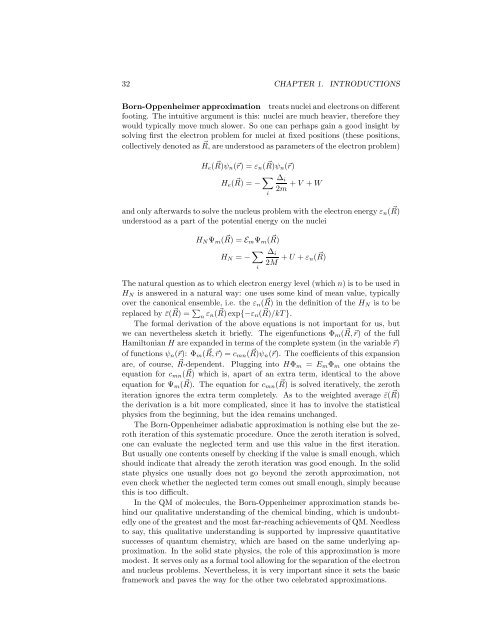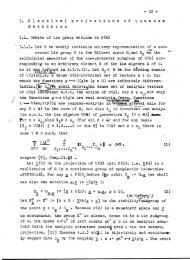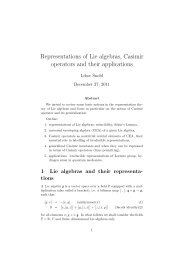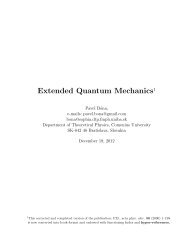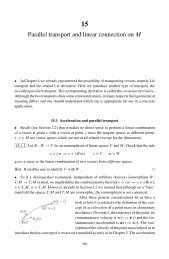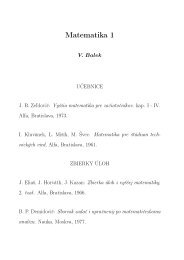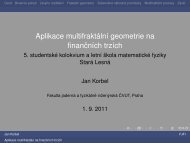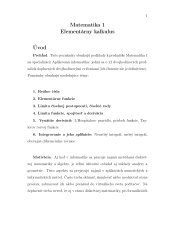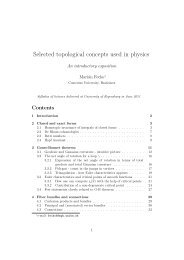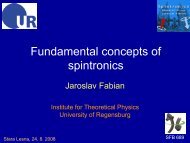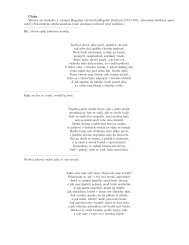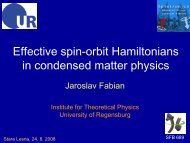Quantum Field Theory I
Quantum Field Theory I
Quantum Field Theory I
Create successful ePaper yourself
Turn your PDF publications into a flip-book with our unique Google optimized e-Paper software.
32 CHAPTER 1. INTRODUCTIONS<br />
Born-Oppenheimerapproximation treatsnucleiandelectronsondifferent<br />
footing. The intuitive argument is this: nuclei are much heavier, therefore they<br />
would typically move much slower. So one can perhaps gain a good insight by<br />
solving first the electron problem for nuclei at fixed positions (these positions,<br />
collectivelydenoted as ⃗ R, areunderstoodasparametersofthe electronproblem)<br />
H e ( ⃗ R)ψ n (⃗r) = ε n ( ⃗ R)ψ n (⃗r)<br />
H e ( ⃗ R) = − ∑ i<br />
∆ i<br />
+V +W<br />
2m<br />
and only afterwardsto solvethe nucleus problem with the electron energyε n ( ⃗ R)<br />
understood as a part of the potential energy on the nuclei<br />
H N Ψ m ( ⃗ R) = E m Ψ m ( ⃗ R)<br />
H N = − ∑ i<br />
∆ i<br />
2M +U +ε n( ⃗ R)<br />
The natural question as to which electron energy level (which n) is to be used in<br />
H N is answered in a natural way: one uses some kind of mean value, typically<br />
over the canonical ensemble, i.e. the ε n ( ⃗ R) in the definition of the H N is to be<br />
replaced by ¯ε( ⃗ R) = ∑ n ε n( ⃗ R)exp{−ε n ( ⃗ R)/kT}.<br />
The formal derivation of the above equations is not important for us, but<br />
we can nevertheless sketch it briefly. The eigenfunctions Φ m ( ⃗ R,⃗r) of the full<br />
Hamiltonian H are expanded in terms of the complete system (in the variable⃗r)<br />
of functions ψ n (⃗r): Φ m ( ⃗ R,⃗r) = c mn ( ⃗ R)ψ n (⃗r). The coefficients of this expansion<br />
are, of course, ⃗ R-dependent. Plugging into HΦm = E m Φ m one obtains the<br />
equation for c mn ( ⃗ R) which is, apart of an extra term, identical to the above<br />
equation for Ψ m ( ⃗ R). The equation for c mn ( ⃗ R) is solved iteratively, the zeroth<br />
iteration ignores the extra term completely. As to the weighted average ¯ε( ⃗ R)<br />
the derivation is a bit more complicated, since it has to involve the statistical<br />
physics from the beginning, but the idea remains unchanged.<br />
The Born-Oppenheimer adiabatic approximation is nothing else but the zeroth<br />
iteration of this systematic procedure. Once the zeroth iteration is solved,<br />
one can evaluate the neglected term and use this value in the first iteration.<br />
But usually one contents oneself by checking if the value is small enough, which<br />
should indicate that already the zeroth iteration was good enough. In the solid<br />
state physics one usually does not go beyond the zeroth approximation, not<br />
even check whether the neglected term comes out small enough, simply because<br />
this is too difficult.<br />
In the QM of molecules, the Born-Oppenheimer approximation stands behind<br />
our qualitative understanding of the chemical binding, which is undoubtedly<br />
oneofthe greatestandthe most far-reachingachievementsofQM.Needless<br />
to say, this qualitative understanding is supported by impressive quantitative<br />
successes of quantum chemistry, which are based on the same underlying approximation.<br />
In the solid state physics, the role of this approximation is more<br />
modest. It servesonlyasaformaltoolallowingforthe separationofthe electron<br />
and nucleus problems. Nevertheless, it is very important since it sets the basic<br />
framework and paves the way for the other two celebrated approximations.


